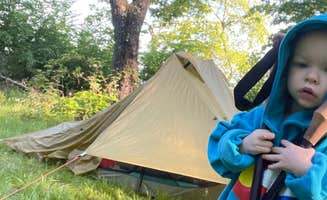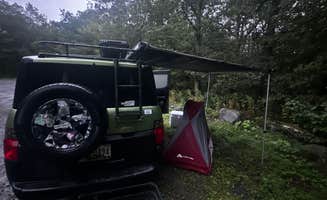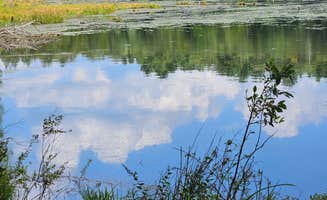Dispersed camping near Minisink Hills, Pennsylvania encompasses primarily undeveloped sites throughout the Delaware Water Gap National Recreation Area and surrounding state forests. Most locations sit between 500-1,200 feet elevation with terrain varying from dense deciduous forest to ridgeline clearings. Many sites require permits from the respective land management agencies, and seasonal restrictions apply during winter months when access roads may be unplowed.
What to do
Hike to Hickok Brook sites: Three primitive lakeside camping spots are available after navigating a rough access road with significant potholes. According to Corey, "The road is very rough with huge potholes so good clearance is a must. It's not a good spot for car camping but you could conceivably drive up to the spots and pull off the road to put up a small tent somewhere." These sites require a permit from the NY state ranger office.
Explore Thunder Swamp Trail System: This network offers multiple overnight options with numerous trail connections. As Benjamin H. notes, "It's a gravel parking lot. Plenty of shade. No one bothered me." The trailhead provides convenient access to extensive hiking through forested terrain.
Overnight at ridge viewpoints: Bake Oven Knob provides two large parking areas serving both day hikers and overnight campers accessing the Appalachian Trail. One visitor reports, "I've overnighted in my van here a bunch, no problems... The hike to the overlook is really lovely; short and rocky."
What campers like
Hammock-friendly terrain: Many sites along the Appalachian Trail corridor feature suitable tree spacing for hammock setups. At Hickok Brook, a camper observed it's a "Really nice quiet place. It's Labor Day weekend, see how many people try to cram in to the very limited camping area." The sloped terrain at some sites makes hammocks preferable to tent platforms.
Wildlife viewing opportunities: Multiple designated sites within the region maintain bear boxes for food storage, indicating regular bear activity. The mixture of wetlands, forests and ridge lines supports diverse wildlife watching.
Solitude options: Several areas provide both communal and isolated camping opportunities. Jason R. found Thunder Swamp Trailhead "Chill for a night. No trouble. Tons of hiking. Went down Saw Creek trail to a marsh." Many sites remain uncrowded on weekdays even during peak season.
What you should know
Permit requirements vary: Free camping near Minisink Hills, Pennsylvania often requires permits depending on the managing authority. One camper at Hickok Brook learned this firsthand: "Where I originally camped was not a spot, according to Ranger. Had to move next to the lake. Need a permit on NY state land. Contact Rangers office of whatever county."
Limited water access: Natural water sources may require significant hiking from campsites. Pack in sufficient water or prepare to filter from streams when available.
Vehicle restrictions: Many locations prohibit motorized access beyond parking areas. As noted at Appalachian Trail Designated Backpacker Campsite 2, "I gave the site only four stars because there's no water nearby, and the views are only mediocre. Also it's a little on the small and sloped side for tent camping."
Strictly enforced fire bans: Open fires are prohibited at most dispersed camping locations. Portable stoves should be used instead for cooking.
Tips for camping with families
Choose sites with established spaces: Some areas offer more developed options suitable for groups. Katharine T. observed, "We stayed here during our section hike through the DWG on the AT. There's plenty of space. We camped nearer to others but there are secluded spots too."
Plan water caching strategies: With limited water access at most sites, families should establish water transport plans. Multiple trips may be necessary depending on group size and consumption needs.
Consider proximity to emergency exits: When camping with children, select locations with reasonable access to roads. Some sites require substantial hiking that may prove challenging for younger campers carrying gear.
Tips from RVers
High-clearance vehicles required: Many dispersed camping access roads near Minisink Hills feature rough terrain unsuitable for standard passenger vehicles. One RVer at Hickok Brook warned, "I drove in thinking that there would be flat places to park a very rugged camper in my full ton diesel pickup. The road is very rough with huge potholes so good clearance is a must."
Limited overnight parking options: Some trailhead parking areas permit overnight vehicle camping but size restrictions apply. Small vans and truck campers have better success than larger RVs at most locations.
Self-contained requirements: With no facilities available at dispersed sites, RV camping requires full self-contained capability including waste storage, water supply, and power.




